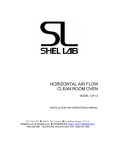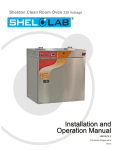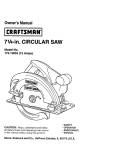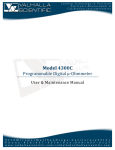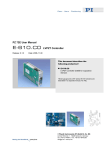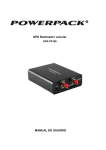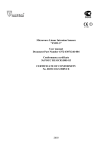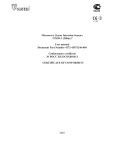Download Crate CR-1 Instruction manual
Transcript
INSTRUCTION MANUAL FOR Horizontal Air Flow Clear Room Oven CR1-2 PLEASE READ THIS MANUAL CAREFULLY BEFORE OPERATION 3, Hagavish st. Israel 58817 Tel: 972 3 5595252, Fax: 972 3 5594529 [email protected] MRC.VER.01-06.10 TABLE OF CONTENTS SECTION 1.0 RECEIVING AND INSPECTION SECTION 2.0 GRAPHIC SYMBOLS SECTION 3.0 INSTALLATION SECTION 4.0 CONTROL OVERVIEW SECTION 5.0 PRECAUTIONS SECTION 6.0 CLEAN ROOM READY INSTRUCTIONS SECTION 7.0 OPERATION SECTION 8.0 MAINTENCE SECTION 9.0 TROUBLESHOOTING AND SERVICE SECTION 10.0 PARTS LIST UNIT SPECIFICATIONS SCHEMATICS REV. 01/10 4861580 This unit is a special purpose oven for professional, industrial or educational use where the preparation or testing of materials is done at approximately atmospheric pressure and no flammable volatile or combustible materials are being heated or placed near or on top of unit. This unit is not intended for hazardous or household locations or use. 2 Section RECEIVING AND INSPECTION 1 Your satisfaction and safety require a complete understanding of this unit. Read the instructions thoroughly and be sure all operators are given adequate training before attempting to put the unit in service. NOTE: This equipment must be used only for its intended application; any alterations or modifications will void your warranty. 1.1 Inspection: The carrier, when accepting shipment, also accepts responsibility for safe delivery and is liable for loss or damage. On delivery, inspect for visible exterior damage, note and describe on the freight bill any damage found, and enter your claim on the form supplied by the carrier. 1.2 Inspect for concealed loss or damage on the unit itself, both interior and exterior. If necessary, the carrier will arrange for official inspection to substantiate your claim. 1.3 Return Shipment: Save the shipping crate until you are sure all is well. If for any reason you must return the unit, first contact your customer representative for authorization. Supply nameplate data, including model number and serial number. Please see the manual cover for information on where to contact customer service. 1.4 Verify that all of the equipment indicated on the packing slip is included with the unit. Carefully check all packaging before discarding. The CR1-2 comes equipped with 4 leveling feet, 4 shelf slides, and 2 shelves. 3 Section GRAPHIC SYMBOLS 2 Your oven has been provided with a display of graphic symbols which is designed to help in identifying the use and function of the available user, adjustable components. 2.1 Indicates that you should consult your manual for further description or discussion of a control or user item. 2.2 Indicates “Adjustable Temperature”. 2.3 Indicates “AC Power ON”. 2.4 Indicates “High Limit Safety”. 2.5 Indicates “Manual Control”. 2.6 Indicates “Potential Shock Hazard” behind this protective partition. 2.7 Indicates “Protective Earth Ground”. 2.8 Indicates “Unit should be recycled” (Not disposed of in land-fill 4 Section INSTALLATION 3 Local city, county or other ordinances may govern the use of this equipment. If you have any questions about local requirements, please contact the appropriate local agency. Installation of the CR1-2 requires hard wiring and should be performed by a qualified electrical technician. The next higher circuit breaker value above the dataplate amperage may be used provided the requirements in article 422 of the National Electric Code are met (USA) or, the National Electric Code that applies in the country where this unit will be operating in. Under normal circumstances this unit is intended for use indoors, at room temperatures between 5° and 40°C, at no greater than 80% Relative Humidity (at 25°C) and with a supply voltage that does not vary by more than 10%. Customer service should be contacted for operating conditions outside of these limits. 3.1 Power Source: The electrical supply circuit to the oven must conform to all national and local electrical codes. Consult the oven’s serial data plate for the voltage, cycle wattage and ampere requirements before making connection. VOLTAGE SHOULD NOT VARY MORE THAN 10% FROM THE SERIAL PLATE RATING. This unit is intended for 50/60 Hz application. A separate circuit is recommended to prevent possible loss of product due to overloading or failure of other equipment on the same circuit. 3.2 Location: In selecting a location, consider all conditions which might affect performance, such as heat from radiators, ovens, autoclaves, etc. Avoid direct sun, fast moving air currents, heating/cooling ducts and high-traffic areas. Allow a minimum of 30 cm between the unit and walls or partitions which might obstruct free air flow. 3.3 Lifting / Handling: These units are heavy and care should be taken to use appropriate lifting devices that are sufficiently rated for these loads. Units should only be lifted from their bottom surfaces. Doors, handles and knobs are not adequate for lifting or stabilization. The unit should be completely restrained from tipping during lifting or transport. All moving parts, such as shelves and trays should be removed and doors need to be positively locked in the closed position during transfer to prevent shifting and damage. 5 3.4 Leveling: The unit must sit level and solidly. Leveling feet are supplied and must be installed in the four holes in the bottom corners of the unit. With the feet installed and the unit standing upright, each foot can be raised by turning it in a counterclockwise direction. Adjust the foot at each corner until the unit stands level and solid without rocking. If the unit must be moved, turn the leveling feet all the way clockwise to prevent damage while moving. 3.5 Cleaning: The unit chamber should be cleaned and disinfected prior to use. Remove shelving and shelving supports and clean thoroughly, including all corners using a suitable disinfectant that is appropriate to your application. Regular periodic cleaning is required. Special care should be taken when cleaning around sensing heads to prevent damage. DO NOT use chlorine-based bleaches or abrasive cleaners as this will damage the stainless steel interior. 3.6 Place shelves in the chamber as desired. 6 Section CONTROL PANEL OVERVIEW 4 4.1 Power Switch: The main power I/O (on/off) switch controls all power to the unit and must be in the I/ON position before any systems are operational. 4.2 High Limit Safety Thermostat: The High Limit Safety is an independent temperature control that must be adjusted by a flat-head screw driver. It prevents temperature runaway in the event that the Main Temperature controller fails. If the chamber temperature rises above the Main Temperature set point, the High Limit maintains temperature at its own set point, preventing sample loss or unit degradation. Please note that it is not recommended that the unit be allowed to operate using only the High Limit to control temperature as temperature uniformity will suffer. 4.3 High Limit Activated: This pilot light is on when the High limit has been activated and has taken control of the heating element. Under normal operating conditions this pilot lamp should never be on. 4.4 Main Temperature Controller: This is a microprocessor based Temperature/Time Control Which has ramp and soak capabilities (Jumo). 4.5 Power Exhaust Outlet: The Power Exhaust outlet is controlled by the Main Temperature Controller. It is located at the back of the unit next to the power cord. Figure 1 7 Section PRECAUTIONS 5 5.1 The bottom surface of the chamber should not be used as a work surface. 5.2 This unit has been designed with a dampered vent(s) from the chamber. In order to work effectively and safely, some precautions will need to be taken by the operator. a. In most applications, the exhaust damper will need to be open during drying or degassing for best results. b. THIS OVEN IS NOT DESIGNED TO HANDLE COMBUSTIBLE GASSES, AND IS NOT AN EXPLOSION PROOF UNIT. Do not place explosive, combustible, or flammable materials into the chamber. c. Some of the out gassed byproducts may be hazardous or unpleasant to operating personnel. If this is the case, the exhaust should be positively ventilated to the outside and dealt with according to local regulations. Your dealer can provide you with a power exhaust which greatly helps under these applications. 5.3 Do not operate near noxious fumes. 5.4 Do not place sealed or filled containers in the oven chamber. 5.5 Do not cut or remove the ground prong from the power cord. Do not use a 2-prong adapter plug. 5.6 Be sure that the power supply is of the same voltage as specified. 5.7 Disconnect the unit from its electrical source before proceeding to make any electrical repairs or replacements. 5.8 If a mercury thermometer is used for verifying chamber temperatures and breakage should occur, all spilled mercury MUST be completely removed from the chamber before continuing operation. 5.9 This is NOT designed for use in Class I, II, or III locations as defined by the National Electric Code. 5.10 This oven is not intended, nor can it be used, as a patient connected device. 8 Section 6 MODEL CR1-2 CLEAN ROOM READY INSTRUCTIONS This oven has been designed to operate at class 100 standards. It is not shipped clean room ready and the instructions below must be followed for proper installation. See Figure 2 6.1 BURN-IN OF THE HEPA FILTER Before using this oven, it is important that the filter be burnt-in properly. During burn-in, the Hepa filter will off gas. Because of this the intake and exhaust ports must be open, with the exhaust ports being ducted outside. A material safety data sheet is included with your operation literature for reference. Note that you should read Section 7.0 and have a clear understanding of how to operate the unit prior to following this procedure. A. B. 6.2 To burn in filter: 1. Set oven at: 125°C for 1 hour; 150°C for 4 hours; 175°C for 1 hour; 200°C for 1 hour. 2. If operating temperature is higher than 200°C, continue the cycle of one hour at 25° increments until the operating temperature is achieved. After burn-in, the interior must be disassembled and cleaned. Make sure unit is unplugged and cooled down before disassembly. When disassembling, use an 8/32 nut driver for removing all the cap nuts. Remove the bottom liner insert before removing the liner side inserts. Do not remove the Hepa filter cover. After burn-in, the filter is very delicate (like the mantel of a lantern) and will fall apart. The casing should only be removed when replacing the filter. CONTROL AREA EXHAUST As part of this design the control compartment is sealed and requires a minimum of 30 CFM (Cubic Feet Per Minute) to be drawn from the control compartment exhaust port. This is required to limit the control 9 compartment temperature and maintain Class 100 integrity. If you are unable to exhaust the minimum 30 CFM from the control compartment, then you must limit the maximum operating temperature to 200°C. Operation of the unit above 200°C, without moving the required 30 CFM through the control compartments exhaust, will result in control degradation and process failure. Not supplying the required 30 CFM may also keep the unit from operating at class 100 specifications by allowing particulars from the control compartment to escape into the room. Figure 2 10 Section OPERATION 7 All control functions are covered in the Jumo Manual. This is a simplified version. Check power supply against unit serial plate. They must match. On ovens that need to be hard wire, must be done by a qualified electrical technician. 7.1 Push the power switch to the I/ON position, turn the high limit thermostat to its maximum position clockwise using a flat-head screw driver. The main temperature controller should be illuminated. The top display is the Process Temperature and the bottom display is the Set Point. 7.2 AUTO TUNING JUMO CONTROL FOR OPTIMUM CONTROL Even though the control was Auto Tuned at the factory, you might choose to tune the control to your specific Set Point. 1. Push the down arrow once. 2. Once the down arrow has been pushed, use the up and down arrow to achieve desired set point. 3. After reaching desired set point, the display should blink once to enter the value. simultaneously for 2 4. To Auto Tune, push the up and down arrow seconds until the Set Point Display flashes Tune. 5. After Tuning Cycle is complete, the bottom display will stop flashing Tune ( ) and return to desired Set Point. 7.3 CHANGING SET POINT ON CONTROL WHEN SETUP AS PROGRAMABLE CONTROLLER 1. To change Set Point, push the Down Arrow once and then use the Up and Down Arrow to change the Setpoint. Up Arrow is pushed first, it will start a program and CAUTION: If the will not allow you to change the Setpoint. To return to NORMAL DISPLAY, push the Up Arrow again. 7.4 CHANGING CONTROL FUNCTION TO SINLE SET POINT CONTROL 1. Push the PGM Button once and then navigate using the Down Arrows until you reach “CONF” in the bottom display. Up and 11 2. After you reach “CONF”, push the PGM Button again and use Up and Down Arrows to navigate until you reach “PRO” in the bottom display and push the “PGM” button again. 3. The display should now read “FNCT” in the bottom display and “2” in the top display. You will need to change the “2” to “0”. To do that, push the “PGM” button once and the “FNCT” should start flashing. While it is flashing, use the Down Arrow to change the “2” to “0”. When the “FNCT” stops flashing, push the exit button repeatedly to return to normal display (Actual Value on Top and Setpoint Value on Bottom.) 4. Now the control is setup as a Single Setpoint Control. Just use the Down Arrows to change Setpoint Value. EXAMPLE PROGRAM Let’s say you want to have the oven to ramp up to 100°C in 30 minutes and control for 1 hour at 100°C. Then you want to ramp up to 150° in 30 Minutes and control for 2 hours. Then you want to cool down to start Set Point with Power Exhaust Outlet activated in one hour. See Graph: EXAMPLE PROGRAM CHART 160 150 150 150 150 150 140 130 TEMPERATUR 120 110 100 100 100 90 80 70 60 50 40 30 25 25 20 30 MINUTES INTERVALS You would program the control like this: STEP1 SP01=25° TPO01=00:30hr STEP2 SP02=100° TPO02=01:00hr STEP3 SP03=100° TPO03=00:30hr STEP4 SP04=150° TPO04=02:00hr STEP5 SP05=150° TPO05=01:00hr STEP6 SP06=25° TPO06=00:00hr OC01-0000 OC02-0000 OC03-0000 OC04-0000 OC05-0100 OC06-0000 The OC parameter 0100 is the value that activates the Exhaust Outlet on the back of the oven. To activate the program that is entered first return to normal display by pushing the Exit Button repeatedly. After Normal Display is reached, push the up arrow once. The lower display should flash STrT 12 and a RAMP/PROGRAM symbol will appear in the lower right side of the display. This indicates the program is running. To stop the program, push the up arrow again and the RAMP/PROGRAM symbol will disappear and the program will end. After program ends, control returns to previous Set Point (starting Set Point). This is explained in Section 6.5 Paragraph 4. OFFSET CALIBRATION This is used to match the process temperature to an independent thermometer. The Offset Calibration is measured in one degree increments. For example, if the process value reads 100°C and the independent thermometer reads 98°C, the Offset Calibration would be set at -2 to match the process value to the independent thermometer. To navigate the control to the Offset Calibration mode, push the PGM button once and then push the up arrow once and the bottom display should read CONF. Then push the PGM button again and the display should say INP. Push the PGM button again and the display should read INP1. Push the PGM button again and the display should read SENS. This enters you in the Input/Configuration Menu. To navigate through the menu, press the up and down arrows. Press the up or down arrow repeatedly until you reach OFFS in the bottom display. Then, push the PGM button once, and the display will start flashing. While flashing, use the up or down arrow to set the desired Offset. After the display stops flashing, push the Exit Button the NORMAL Display is reached. 7.5 repeatedly until Setting High Limit: Prior to setting the High Limit Control be certain the Main temperature Control has reached the input set point and has remained stable for several hours. This will insure that the High Limit is set at the proper temperature. As stated in 4.3, the High Limit control should be at maximum position, clockwise. Now turn the thermostat counter-clockwise using a flat-head screwdriver until the High Limit Activated indicator light comes on. Next turn the thermostat clockwise just until the indicator light turns off. Then turn the thermostat clockwise two (2) minor increments on its scale past the point where the indicator light went out. This will set the High Limit at approximately 10°C above the Main Temperature set point. 13 Section MAINTENANCE 8.1 8 Cleaning: The unit chamber should be cleaned and disinfected on a regular basis. Remove shelving & shelving supports then clean thoroughly, including all corners using a suitable disinfectant that is appropriate to your application. Regular periodic cleaning is required. Special care should be taken when cleaning around sensing heads to prevent damage. DO NOT use chlorine based bleaches or abrasive cleaners as this will damage the stainless steel interior. DO NOT use spray cleaners that might leak through openings and cracks and get on electrical parts or that may contain solvents that will harm the coatings. Warning: Never clean the unit with alcohol or flammable cleaners with the unit connected to the electrical supply. Always disconnect the unit from the electrical service when cleaning and assure all volatile or flammable cleaners are evaporated and dry before reattaching the unit to the power supply. 8.2 Storage: If the oven is to be turned off it can be reactivated without controller adjustments. Prior to storage the interior should be wiped dry to eliminate contamination. If the unit is to be transported disconnect the power supply, remove shelving and screw the leveling feet in. See Section 3.3 Lifting/handling for transport instructions. 8.3 There is No Maintenance required on the electrical components. If the unit fails to operate as specified please review the troubleshooting guide prior to calling for technical support. 8.4 Hepa Filter Replacement: Replace the hepa filter when the control compartment exhaust becomes noticeably reduced. The amount of time a Hepa filter will last depends on the environment in which the unit operates. This will have to be determined by the end user to establish standard operating procedures or maintenance schedule. 14 Section TROUBLESHOOTING 9 TEMPERATURE Temperature too high 1/ controller set too high-see your Jumo users manual 2/ controller failed on – call Customer Service 3/ wiring error – call Customer Service Display reads "HI" or "400"+ Probe is unplugged, is broken or wire to sensor is broken – trace wire from display to probe; move wire and watch display to see intermittent problems Chamber temp spikes over set point and then settles to set point Recalibrate – see Jumo users manual Temperature too low 1/ high limit set too low – see section 4.5 2/ controller set too low – see Jumo users manual 3/ unit not recovered from door opening – wait for display to stop changing 4/ unit not recovered from power failure or being turned off – incubators will need 24 hours to warm up and stabilize 5/ element failure – call Customer Service 6/ controller failure – confirm with front panel lights that controller is calling for heat 7/ high limit failure – confirm with front panel lights that High Limit is operating correctly 8/ wiring problem – check all functions and compare wiring to owners manual - especially around any areas recently worked on 9/ loose connection – check shadow box for loose connections Display reads "LO" 1/ sensor is plugged in backwards – call Customer Service 2/ if ambient room temperature is lower than range of unit – compare set points and ambient temperature to rated specifications in Section 10.0 Unit will not heat over a temperature that is below set point 1/ confirm that blower motor is moving and that amperage and voltage match data plate – check blower motor motion in shadow box and feel for air movement in chamber 2/ confirm that set point is set high enough –turn High Limit clockwise and see if High Limit light comes on 3 / check connections to sensor 4/ check calibration – using independent reference thermometer, follow instructions in Jumo users manual 15 Unit will heat up at all 1/ verify that controller is asking for heat by looking for controller light – if controller light is not on, there is a problem with the controller 2/check amperage – amperage should be virtually at maximum rated (data plate) amperage 3/ do all controller functions work? 4/ is the High Limit set high enough? – for diagnostics, should be fully clockwise with the pilot light never on 5/ has the fuse/circuit breaker blown? Indicated chamber temperature unstable 1/ ±0.1 may be normal 2/ is blower motor working? – remove top panel and verify movement of blower motor in shadow box 3/ is ambient room temperature radically changing – either door opening or room airflow from heaters or air conditioning? – stabilize ambient conditions 4/ it may happen if exhaust stack is 100% open or if power exhaust is cycling – adjust stack to at least ¼ closed 5/ sensor miss-located, damaged or wires may be damagedcheck mounts for control and High Limit sensors, then trace wires between sensors and controls 6/ calibration sensitivity – call Customer Service 7 / high limit set too low – be sure that High Limit is more than 5 degrees over desired set point; check if High Limit pilot is on continuously; turn controller knob completely clockwise to see if problem solved then follow instructions in Section 7.5 for correct setting 8/ electrical noise – remove nearby sources of RFI including motors, arcing relays or radio transmitters 9/ bad connection on temperature sensor or faulty sensor – check connectors for continuity and mechanical soundness while watching display for erratic behavior; check sensor and wiring for mechanical damage 1 0 / bad connections or faulty solid state relay – check connectors for mechanical soundness and look for corrosion around terminals or signs of arcing or other visible deterioration Will not maintain set point 1 / assure that set point is at least 5 degrees over ambient room temperature 2/ see if ambient is fluctuating Display and actual reference thermometer don’t match 1/ calibration error – see Jumo users manual 2/ temperature sensor failure – call Customer Service 3/ controller failure – call Customer Service 4/ allow at least two hours to stabilize 5/ verify that reference thermometer is certified See above Can't adjust set points or calibration 1/ turn entire unit off and on to reset 2/ if repeatedly happens, call Customer Service Calibrated at one temperature, but not at another This can be a normal condition when operating temperature varies widely. For maximum accuracy, calibration should be done at or as close to the set point temperature. 16 MECHANICAL Door not sealing 1/ check physical condition of gasket 2/ assure that gasket is in original location Motor doesn't move 1/ if shaft spins freely: check connections to motor and check voltage to motor 2/ if shaft rubs or is frozen, relieve binding and retest Motor makes noise 1) Make sure that the fan or blower wheel is not contacting its housing. Adjust the motor mounting bracket position to re-center the fan or blower wheel, if necessary. 2) Check the fan or blower wheel for damage or out of balance condition. Replace the fan or blower wheel if it is damaged or out of balance. 3) Turn the motor shaft to make sure that it spins freely. If it binds or the bearings make a rubbing or scrapping sound then replace the motor. OTHER Controller on at all times - "locked-up" 1/ Adjust set point to room temperature. If the light goes out but is still heating, replace the solid state relay. 2/ turn unit off and on to reset 3/ if cannot change any condition on the front panel, call Customer Service Controller timer resets on its own 1/ confirm that power from wall is consistent and within specs 2/ call Customer Service with serial number Front panel displays are off 1/ Check for wire damage. Unit or wall fuse/circuit breaker is blown 1/ check wall power source 2/ compare current draw and compare to specs on data plate 3/ see what other loads are on the wall circuit Unit will not turn on 1/ check wall power source 2/ check fuse/circuit breaker on unit or in wall 3/ see if unit is on, e.g., fan or heater, and just controller is off 4/ check all wiring connections, esp. around the on/off switch Unit is smoking –out of box 1/ put unit under vent and run at full power for one hour. 2/ follow special burn in procedures in section 6.0. Contamination in chamber 1/ see cleaning procedure in operator’s manual 2/ develop and follow SOP for specific application; include definition of cleaning technique and maintenance schedule Contamination in sample 1/ see “Contamination in chamber. 17 SERVICE If this product should require service, contact your service representative. For information on where to reach customer service please see the front cover of this manual. Should return of this product be necessary a return Authorization number must be obtained and the product shipped according to your representatives instructions to the indicated service center. If a return authorization number is not obtained then the product will be returned back to the sender. To insure prompt handling, the return authorization number should be placed on the outside of the package and a detailed explanation of the return enclosed with the item. After receiving the Return Authorization number, the item must be received within 30 days if not the return authorization will be void. 18 Section PARTS LIST 10 Units are 220 Volt. Description Part No. Hepa filter Blower Motor 9990503 4880512 Convenience Outlet 101483 Cooling Fan X1000748 Fan Guard 2600518 Filtered inlet 2800503 Heating Element 9570831 High Limit Controller 1750571 High Limit Indicator Pilot Lamp 200020 Leveling Feet 200129 ON/OFF Switch 103351 Power Relay 100064 Shelf Shelf Standards Solid State Relay 5121194 5121189 102162 Temperature Probe Main Temperature Controller 101827 1750803 19 UNIT SPECIFICATIONS These units are 240 VAC. See the individual data plate of the unit for specific ratings. Weight Shipping Net CR1-2 425 lbs. 325 lbs. Dimensions Exterior WxDxH Interior WxDxH (in) (in) CR1-2 35 x 30.25 x 38 Capacity Cubic Feet CR1-2 4.0 Temperature CR1-2 POWER CR1-2 CR1-2 Range Uniformity Control 40 to 200°C +1.0° @ 110°C 0.1°C VOLTAGE 220V Recovery Time 17 x 20 x 20.125 AMPERAGE WATTAGE HERTZ 11.5 AMPS 2000 WATTS 50\60 150°C (door open 30 sec) 6 min 20 WIRE DIAGRAM 21





















